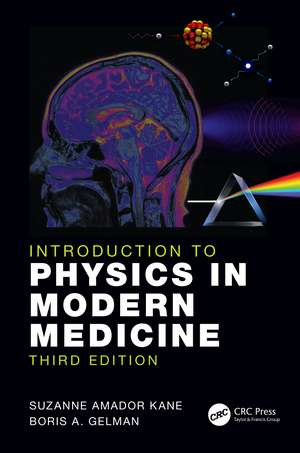Introduction to Physics in Modern Medicine
Autor Suzanne Amador Kane, Boris A. Gelmanen Limba Engleză Paperback – 3 mar 2020
From x-rays to lasers to magnetic resonance imaging, developments in basic physics research have been transformed into medical technologies for imaging, surgery and therapy at an ever-accelerating pace. Physics has joined with genetics and molecular biology to define much of what is modern in modern medicine and allied health.
Covering a wide range of applications, Introduction to Physics in Modern Medicine, Third Edition builds further on the bestselling second edition. Based on the courses taught by the authors, the book provides medical personnel and students with an exploration of the physics-related applications found in state-of-the-art medical centers.
Requiring no previous acquaintance with physics, biology, or chemistry and keeping mathematics to a minimum, the application-dedicated chapters adhere to simple and self-contained qualitative explanations that make use of examples, illustrations, clinical applications, sample calculations, and exercises. With an enhanced emphasis on digital imaging and computers in medicine, the text gives readers a fundamental understanding of the practical application of each concept and the basic science behind it.
This book provides medical students with an excellent introduction to how physics is applied in medicine, while also providing students in physics with an introduction to medical physics. Each chapter includes worked examples and a complete list of problems and questions.
That so much of the technology discussed in this book was the stuff of dreams just a few years ago, makes this book as fascinating as it is practical, both for those in medicine as well as those in physics who might one day discover that the project they are working on is the basis for the next great medical application.
Features:
- Introduces state-of-the art and emerging medical technologies such as optical coherence tomography, x-ray phase contrast imaging, and ultrasound-mediated drug delivery
- Covers hybrid scanners for cancer imaging and the interplay of molecular medicine with MRI, CT and PET in addition to intensity-modulated radiation therapy and new forms of cancer treatments such as proton and heavy-ion therapies
- Offers an enhanced emphasis on digital imaging and dosimetry including recent innovations in the pixel-array x-ray detectors, ultrasound matrix transducers and direct-ion storage dosimeters
| Toate formatele și edițiile | Preț | Express |
|---|---|---|
| Paperback (1) | 420.63 lei 3-5 săpt. | +29.59 lei 7-13 zile |
| CRC Press – 3 mar 2020 | 420.63 lei 3-5 săpt. | +29.59 lei 7-13 zile |
| Hardback (1) | 992.63 lei 6-8 săpt. | |
| CRC Press – 3 mar 2020 | 992.63 lei 6-8 săpt. |
Preț: 420.63 lei
Preț vechi: 457.20 lei
-8% Nou
80.50€ • 83.56$ • 67.12£
Carte disponibilă
Livrare economică 01-15 martie
Livrare express 15-21 februarie pentru 39.58 lei
Specificații
ISBN-10: 113803603X
Pagini: 450
Ilustrații: 17 Tables, black and white; 184 Line drawings, black and white; 78 Halftones, black and white; 262 Illustrations, black and white
Dimensiuni: 156 x 234 x 25 mm
Greutate: 0.7 kg
Ediția:3 ed
Editura: CRC Press
Colecția CRC Press
Cuprins
Notă biografică
Boris Gelman, Ph.D. is an Associate Professor of Physics at New York City College of Technology of The City University of New York. He is interested in undergraduate science curriculum development and in improving learning outcomes and student experience. He conducts research in theoretical nuclear physics, studying the forces that give rise to the properties of atomic nuclei and to the structure of neutrons and protons.
Descriere
From x-rays to lasers to magnetic resonance imaging, developments in basic physics research have been transformed into medical technologies for imaging, surgery and therapy at an ever-accelerating pace. Physics has joined with genetics and molecular biology to define much of what is modern in modern medicine and allied health.
Covering a wide range of applications, Introduction to Physics in Modern Medicine, Third Edition builds further on the bestselling second edition. Based on the courses taught by the authors, the book provides medical personnel and students with an exploration of the physics-related applications found in state-of-the-art medical centers.
Requiring no previous acquaintance with physics, biology, or chemistry and keeping mathematics to a minimum, the application-dedicated chapters adhere to simple and self-contained qualitative explanations that make use of examples, illustrations, clinical applications, sample calculations, and exercises. With an enhanced emphasis on digital imaging and computers in medicine, the text gives readers a fundamental understanding of the practical application of each concept and the basic science behind it.
This book provides medical students with an excellent introduction to how physics is applied in medicine, while also providing students in physics with an introduction to medical physics. Each chapter includes worked examples and a complete list of problems and questions.
That so much of the technology discussed in this book was the stuff of dreams just a few years ago, makes this book as fascinating as it is practical, both for those in medicine as well as those in physics who might one day discover that the project they are working on is the basis for the next great medical application.
Features:
- Introduces state-of-the art and emerging medical technologies such as optical coherence tomography, x-ray phase contrast imaging, and ultrasound-mediated drug delivery
- Covers hybrid scanners for cancer imaging and the interplay of molecular medicine with MRI, CT and PET in addition to intensity-modulated radiation therapy and new forms of cancer treatments such as proton and heavy-ion therapies
- Offers an enhanced emphasis on digital imaging and dosimetry including recent innovations in the pixel-array x-ray detectors, ultrasound matrix transducers and direct-ion storage dosimeters
